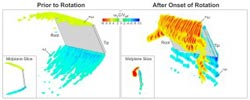The Secrets of a Bug's Flight

Matthew Bross<br><br>The left image represents a non-rotating wing in the presence of incident flow; it exhibits a stalled state. The right image, taken shortly after the onset of rotation (at 36 degrees), shows a stable, lift-generating flow structure.<br>
Researchers have identified some of the underlying physics that may explain how insects can so quickly recover from a stall in midflight — unlike conventional fixed wing aircraft, where a stalled state often leads to a crash landing.
The analysis, in which the researchers studied the flow around a rotating model wing, improves the understanding of how insects fly and informs the design of small flying robots built for intelligence gathering, surveillance, search-and-rescue, and other purposes. The work is described in the journal Physics of Fluids.
An insect such as a fruit fly hovers in the air by flapping its wings — a complex motion akin to the freestyle stroke in swimming. The wing rotates in a single plane, and by varying the angle between the plane and its body, the insect can fly forward from a hovering position.
To simulate the basics of this action, Matthew Bross and colleagues at Lehigh University in Bethlehem, PA, studied how water flows around a rotating model wing consisting of a rectangular piece of acrylic that is twice as long as it is wide. The rotation axis is off to the side of the wing and parallel to its width, so that it rotates like half of an airplane propeller. To simulate forward motion — a scenario in which the insect is accelerating or climbing — the researchers pumped water in the direction perpendicular to the plane of rotation.
“We were able to identify the development of flow structure over an insect-scaled wing over a range of forward flight velocities,” Bross explained. The researchers made detailed three-dimensional computer visualizations of the flow around the wing, finding that a leading-edge vortex — a feature crucial for providing lift — almost immediately appears once the wing starts to rotate after a stalled state.
The article, “Flow structure on a rotating wing: effect of steady incident flow,” by Matthew Bross, Cem Alper Ozen and Donald Rockwell appears in the journal Physics of Fluids. See: http://dx.doi.org/10.1063/1.4816632
ABOUT THE JOURNAL
Physics of Fluids is devoted to the publication of original theoretical, computational, and experimental contributions to the dynamics of gases, liquids, and complex or multiphase fluids. See: http://pof.aip.org
Media Contact
More Information:
http://www.aip.orgAll latest news from the category: Physics and Astronomy
This area deals with the fundamental laws and building blocks of nature and how they interact, the properties and the behavior of matter, and research into space and time and their structures.
innovations-report provides in-depth reports and articles on subjects such as astrophysics, laser technologies, nuclear, quantum, particle and solid-state physics, nanotechnologies, planetary research and findings (Mars, Venus) and developments related to the Hubble Telescope.
Newest articles

High-energy-density aqueous battery based on halogen multi-electron transfer
Traditional non-aqueous lithium-ion batteries have a high energy density, but their safety is compromised due to the flammable organic electrolytes they utilize. Aqueous batteries use water as the solvent for…

First-ever combined heart pump and pig kidney transplant
…gives new hope to patient with terminal illness. Surgeons at NYU Langone Health performed the first-ever combined mechanical heart pump and gene-edited pig kidney transplant surgery in a 54-year-old woman…

Biophysics: Testing how well biomarkers work
LMU researchers have developed a method to determine how reliably target proteins can be labeled using super-resolution fluorescence microscopy. Modern microscopy techniques make it possible to examine the inner workings…





















